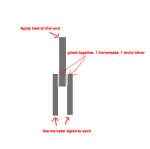- Joined
- Aug 30, 2008
- Messages
- 6,891
- Points
- 83
you can also do a simple experiment to test ho effective it is.
get 3 flat pieces of aluminum, and glue two pieces on each side of a single piece.
glue 1 with the homemade glue, and the other with arctic silver. tape a thermometer to each prong, and then apply heat to the first piece.
whichever piece heats up more, it's transferring more heat through the glue and into the metal.
Here is a picture.
this would also be helpful for finding out what ratio of epoxy/powder works best

get 3 flat pieces of aluminum, and glue two pieces on each side of a single piece.
glue 1 with the homemade glue, and the other with arctic silver. tape a thermometer to each prong, and then apply heat to the first piece.
whichever piece heats up more, it's transferring more heat through the glue and into the metal.
Here is a picture.
this would also be helpful for finding out what ratio of epoxy/powder works best
Attachments
Last edited:






